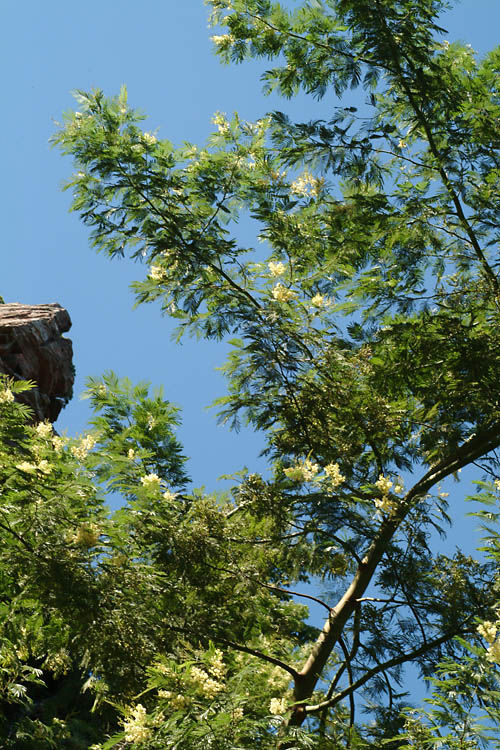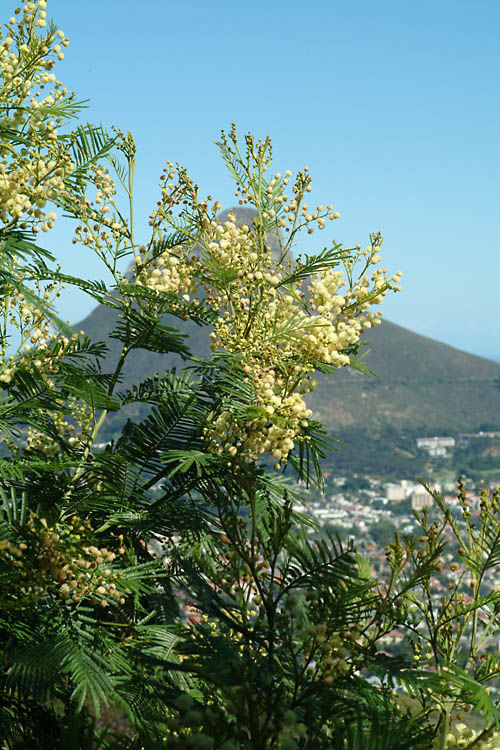Black Wattle
acacia mearnsii
Also known as: ["Australian Acacia","Swamp Wattle"]
Overview
A fast-growing, deciduous tree native to Australia, known for its yellow flowers and invasive potential in some regions.
Benefits & Perks
["fast growing","fragrant flowers","wildlife attractant (bees, butterflies, birds)","drought tolerant"]
Botanical Classification
| Phylum: | Magnoliophyta |
| Class: | Magnoliopsida |
| Order: | Fabales |
| Family: | Fabaceae |
| Genus: | Acacia |
| Botanical Name: | Acacia mearnsii |
Plant Characteristics
Basic Information
- Category: Trees
- Suitable Location: outdoor garden in full sun
- Suitable For:
- Is Weed: No
- Allergenicity: moderate
Environmental Needs
- Climate: {"temperatureRange":"5–40°C"}
- Hardiness: {"zones":"9–11"}
- Misting: rarely required, only if ambient humidity is very low
- Drainage: Fast-draining to prevent waterlogging.
- Soil Type: Well-draining, slightly acidic soil mix such as cactus/succulent mix with added organic matter.
Maintenance Level
- Maintenance Level: moderate
- Toughness Level: high
- Pruning Frequency: Annually, after flowering or in late winter/early spring before new growth begins.
- Pruning Intensity: Moderate. Remove up to one-third of old growth to rejuvenate the plant.
Care Details
Ideal Sunlight Coverage:
Full sun (6–8 hours of direct sunlight daily). Tolerates partial shade but may become leggy with insufficient light.
Sunlight Tolerance Tips:
Acclimate plants gradually to intense sunlight to prevent scorching. For indoor placement, provide the brightest possible location with direct sunlight exposure.
Care Requirements
Care Difficulty
easymoderate
Sunlight
full sun
Rotate plant weekly for even growth; use sheer curtains to filter harsh midday sun; avoid sudden light changes.
Watering
every 7–10 days during active growth, reduce in winter
Water thoroughly until runoff, allow soil to dry partially between waterings, and avoid frequent shallow watering.
Soil
well-drained, loamy soil
pH: Slightly acidic to neutral (pH 5.5–7.0).
Ensure pots have drainage holes; avoid heavy clay soils; test pH if symptoms arise.
Temperature
Thrives in warm conditions, ideal range 60–85°F (15–29°C). Tolerates mild frosts but prefers frost-free environments.
Avoid placing near drafty windows or heat vents; use shade cloth in extreme heat; monitor soil temperature for root health.
Fertilizing
every 2–3 months during growing season
Fertilize only when actively growing; avoid over-fertilization which can burn roots; flush soil occasionally to prevent salt buildup.
Propagation
Methods
Stem cuttings or seed. Stem cuttings are more reliable for consistent results.
Step-by-Step Propagation Guide
- Take 4–6 inch cuttings.
- Remove lower leaves.
- Dip in rooting hormone.
- Plant in medium.
- Maintain humidity.
- Keep warm and bright.
Best Time: Late spring to early summer when temperatures are warm and humidity is moderate.
Environment
Warm (70–75°F), humid (60–70%), and bright but indirect light. Protect from direct sun and drafts.
Medium
Well-draining mix of perlite and peat moss or cactus/succulent potting soil.
Hormone
Recommended to use rooting hormone to improve success rates.
Timeline
Roots typically form in 4–8 weeks; establishment may take 3–6 months.
Tools Needed
Pruning shears, rooting hormone, small pots, misting spray bottle, plastic bags or propagation dome.
Quick Tips
Use healthy, non-flowering stems; maintain consistent moisture; provide bottom heat if possible; avoid disturbing cuttings.
Pruning & Repotting
Pruning Guide
Method
Selective thinning of branches to improve airflow and light penetration. Cut just above a leaf node or bud.
Pruning Plan
Prune to maintain shape, encourage bushiness, and remove dead or diseased wood. Prune after flowering to avoid cutting off buds.
Tools
Pruning shears, loppers (for larger branches), sterilizing solution (e.g., rubbing alcohol).
Checklist
Sterilize tools; prune after flowering; remove dead/diseased wood; shape evenly; clean up debris.
Repotting Guide
Best Season
Early spring before active growth begins.
Pot Size
Increase pot size by 2–3 inches in diameter.
Method
Remove plant gently; trim any circling roots; place in a slightly larger pot with fresh, well-draining soil; water thoroughly after repotting.
Suggestions
Repot every 2–3 years or when roots fill the container. Acacia mearnsii prefers being slightly root-bound but benefits from fresh soil.
Checklist
Choose appropriate pot size; prepare fresh soil mix; trim roots if needed; water well after repotting; place in shade for a few days.
Advanced Care Tips
Watering Mastery
Watering Checklist
Check soil moisture before watering; water deeply; ensure drainage; adjust frequency seasonally.
How to Apply Water Properly
Water directly at the root zone, ensuring even saturation to a depth of 6–8 inches. Ensure excess water drains away to prevent root rot. Water early in the morning to minimize evaporation.
Watering Schedule Tips
Water deeply once every 7–10 days during active growth in spring and summer; reduce frequency to every 2–3 weeks in fall and winter. Adjust based on rainfall and soil moisture retention.
Soil Improvement
Add perlite or coarse sand to improve drainage; incorporate compost for organic matter; use pine bark fines for acidity.
Temperature Stress Management
Signs of Temperature Issues
Chlorosis or leaf drop in cold stress; wilting or scorched leaves in excessive heat.
Cold Stress
Low temperatures slow growth and may cause leaf drop or dieback. Prolonged cold can damage roots and lead to fungal infections.
Solution: Protect from frost with frost cloth or mulch; ensure good drainage to prevent cold waterlogging; move potted plants indoors during freezes.
Hot Stress
Excessive heat can cause leaf scorch, wilting, and reduced flowering. High humidity combined with heat may promote fungal diseases.
Solution: Provide afternoon shade if possible; increase watering frequency; use mulch to retain soil moisture; ensure good air circulation.
Fertilizing Guide
Fertilizing Checklist
Use balanced fertilizer; apply in spring; dilute liquid fertilizers; avoid winter feeding.
Fertilizing Method
Use a balanced, slow-release fertilizer in early spring. Dilute liquid fertilizer to half-strength if applied monthly during growing season. Avoid fertilizing in winter.
Common Problems & Solutions
Toxicity Warning
Cats
Slightly ToxicAcacia mearnsii poses a slight risk to cats if ingested, with the seeds and bark being the most toxic parts. Ingestion can cause mild gastrointestinal distress and other symptoms, though severe toxicity is rare.
⚠️ Symptoms:
🌿 Toxic Parts:
⚡ Toxic If:
if eaten
Dogs
Slightly ToxicThe seeds and bark of Acacia mearnsii can be toxic to dogs if ingested, leading to gastrointestinal upset and other mild symptoms. While not highly toxic, ingestion should be avoided to prevent discomfort.
⚠️ Symptoms:
🌿 Toxic Parts:
⚡ Toxic If:
if eaten
Humans
Slightly ToxicAcacia mearnsii contains toxic compounds, primarily in its seeds and bark, which can cause mild to moderate physiological effects upon ingestion. The plant's toxicity is not severe but can lead to discomfort and adverse reactions in humans.
⚠️ Symptoms:
🌿 Toxic Parts:
⚡ Toxic If:
if eaten
Frequently Asked Questions
Q: Is Acacia mearnsii invasive?
A: Yes, it is considered invasive in many regions outside its native range.
Q: What are the uses of Black Wattle?
A: It is used for timber, tannin production, and as a source of firewood.
Q: How toxic is Black Wattle to pets?
A: It is mildly toxic to dogs and cats if ingested.
Quick Reference
| Family: | Fabaceae |
| Care: | easy |
| Light: | full sun |
| Water: | every 7–10 days during activ |
Get Expert Care Tips
Download the Plantious app for personalized care reminders and plant identification!
Google Play App Store








